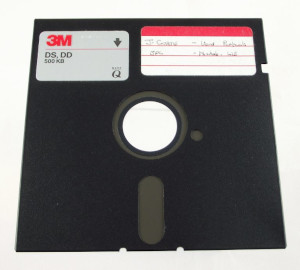
|
This site is running on a 286 PC, booted and served
entirely from a 90mm floppy disk. See current
server stats. All content on this site is provided by the Museum of Obsolete Media, curated by Jason Curtis. My sincerest thanks to Jason for providing me with the worthy challenge of exhibiting his work in the only appropriate way: The Floppy Disk Museum: The Bootable Floppy edition! |


The 5.25-inch floppy disk (or 'diskette') was a magnetic disk format introduced by Shugart Associates in 1976, as a replacement for the 8-inch floppy disk that was considered too large for newer desktop machines. In its early years it was known as the minifloppy to distinguish it from the the 8-inch floppy.
Like the 8-inch floppy, the 5.25-inch disk consisted of a disk of thin and flexible magnetic storage medium, sealed in a rectangular plastic carrier lined with fabric that removed dust particles. Write protection was carried out by affixing an adhesive tab.
By 1978 a number of manufacturers were producing disks, in competing formats including hard and soft-sector versions, and different encoding schemes.
Initially, 5.25-inch disks had a capacity of 110 KB, with a double-density disk introduced in 1978 with a capacity of 360 KB, and quad-density introduced in the early 1980s with a capacity of 720 KB.
In 1984, IBM introduced the high-density 1.2 MB disk in its PC AT, but by the time of the launch of the PS/2 line in 1987 moved to 3.5-inch floppy disks, as Apple had already done with its Macintosh line in 1984. By 1988 the 3.5-inch was outselling it, and by the mid-1990s the 5.25-inch disk had virtually disappeared, and there was no option to purchase Windows 95 on 5.25-inch disks.
All disks were coated on both sides whether single or double-sided, but only double-sided disks were certified error-free on both sides of the media. However, it was possible to use both sides of a single-sided disk in single-sided drives, by making or buying so-called 'flippy' disks. More expensive dual-head drives which could read both sides of the disk without turning it over were later produced, and eventually became used universally.
Dimensions: 133.3 mm * 133.3 mm * 1.6 mm
Capacity: 110 KB to 1.2 MB